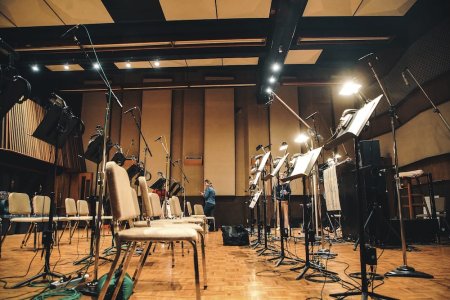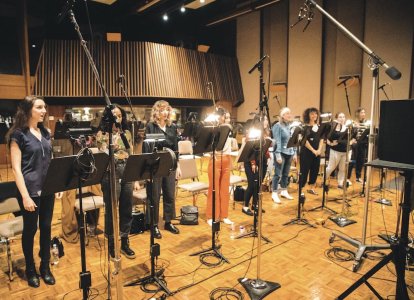OleJoergensen
Senior Member
Thank you for sharing this knowledge Mike.
 I'm one of those always interested in this kind of thing, and to see it with real data included, well, what can I say? I'll follow this thread with utmost interest.
I'm one of those always interested in this kind of thing, and to see it with real data included, well, what can I say? I'll follow this thread with utmost interest.How do developers like yourself pick the performers to sample? Or in other words, do you already know some singers who you intend to hire? How do you go about finding people, and vetting them, for a project like this?





LOVE these updates Mike, for real!hy reinvent a wheel they already invented? So we’ll probably just copy them and go with these ranges:
Basses - E1 to Db3
Tenors - B1 to G3
Altos - E2 to Eb4
Sopranos - B2 to A4
Yep. David Kudell came in on Wednesday and got some great footage. It's a lot to look through, and I'm not sure what we'll actually do with it, but I'm glad we did that.I hope you're shooting video of the work too.
Not very accurately. Some things are quicker than we expect and others take longer. Although these weren't union sessions, we abided by union rules, including 10 minute breaks each hour. So if we finished an articulation and had ten minutes left in the hour, I might move to a really quick articulation that might not have been on the day's agenda. Or we might start a regular articulation and just finish the first few notes before taking a break.@Mike Greene , are you making an hour to hour schedule for the recordings normally and how accurate can you plan that?
Not trying to be a salesman, but this won't be a typical oos and ahs library.I'll probably get flamed for this, but how many oohs and aahs choir library do we need? I'm really looking forward to the day we'll have real word builder libraries available.

That's the fear, because none of my costs are refundable, and especially in times of covid, things can go terribly wrong.Not to make this about me, but yeah, choir libraries sure can involve messy logistics. Hadziha has two sets of vowels recorded with two sets of singers because after starting the recording one singer moved to a neighboring country, the whole thing died, and it took months to recruit new ones. But hey, it sure was worth it, it's probably sold about as well as the solo strings and orcs, and definitely much better than the solo voices.
Hopefully things go smoother for you, and nobody loses their voice three days in or anything like that.
Good idea. I've now added them to the first post.You should consider linking all subsequent updates in your first posts, otherwise it will be hard to follow for future readers. My 2 cents.
I tend to think the same way, and that's what we did with the Realivox libraries, which have extendable ranges. We'll mostly likely do the same with Sunset Choirs.Just wanted to suggest maybe a feature button/switch to stretch the range up and down a tone or two, or something. I've seen it on a couple vocal libraries. It doesn't sound amazing but it can get you out of a jam if your idea just wants to go up that extra step beyond the normal range.
I'm loving these write ups, Mike! I'm curious how you decided the order of the vowels to sing. It seems reasonable to me that changing the order would change the performance - for example, singing 'oh' when preceded by 'ooh' will sound different from if it is preceded by 'ah'. Obviously, this might not make a lick of a difference, but I'm curious if it's something that matters at all, and if you might have experimented with it.WEEK #3 - THE RECORDING SESSIONS:
What kind of moron books five 13-hour days in a row? This kind of moron, that’s who! Now, I don’t take my accusations of moronhood lightly, but let’s look at the evidence:
Exhibit A - Five days is a lot to prepare for, and given that we only had two weeks to make those preparations (what was I thinking???), there was no way I would be completely ready. That turned out to be problematic in a few instances. (Which I’ll explain below.)
Exhibit B - You get tired after five days. Plus I added an extra half day on Saturday. I was pretty loopy by then. I was still gittin’ ‘er done, but not at maximum efficiency.
Now, with that said, do I regret booking a five day lockout with only two weeks to prepare? Not really. Certainly there would be some aspects of the recording sessions that might have gone more smoothly, but we got some really good stuff recorded, and we got almost everything done on the list. The sessions might not have gone quite as efficiently as I would have liked, but prep time isn’t free, either. If another week of prep time would have saved two hours of recording time … that’s not worth it to me. I’d rather pay the overage and not “waste” the week of my own time. Plus, adding weeks to the preparation period pushes back the eventual release.
This is just me, mind you, so don’t interpret this as “advice.” I have the resources to be somewhat cavalier about these things, and at this stage in my life, Realitone is more about having fun than putting my nose to the grindstone, so I like the excitement of flying by the seat of my pants.
Plus, the “Sunset” concept is so unusual that you sort of have to do a lot of this on the fly. Try something, see how it sounds, and then go from there. Too much planning can be self defeating, and a lot of it goes out the window anyway. Like giant charts that I spent hours making, but never used. What a waste.
And truth be told, a number of things I wish I were better prepared for … I’m not so sure I could have anticipated. Starting with:
VOCALS AREN’T STRINGS, FOLKS
You heard it here first! With Sunset Strings, there were names for everything: Ricochets, col legno, bartok pizz, seagulls, or whatever. You call it out, and they play it. Perfectly.
Vocals don’t have an equivalent terminology. “Sound like a weirdo” isn’t quite descriptive enough, so you have to come up with ways to explain what you’re looking for. And then (and here’s the even trickier part), make sure the men interpret your instructions the same way as the women did, so they’ll be consistent. You don't women to have a narrow vibrato and men to have a wide one.
Dynamics are trickier with singers than with string players. For the strings, Sul Tasto was the default. For the singers, it was mp, which was a little more open to interpretation. On the bright side, this is less of an issue than it may seem, because although the singers may be slightly louder or quieter on various days, the actual timbre doesn’t change that much from p to m. (I did experiments with this ahead of time.) Still, it was something I had to keep an eye on.
The biggest difference between recording strings and vocals is that strings don’t have vowels. With Sunset Strings, we could record “Slow Bends” for attacks and releases, and they would work for most of the sustains - Sul Tasto, Normale, Flautando, even Tremolos. We did have to do some under-the-hood volume adjustments, but it all worked.
With Choir, we had to record separate attack/release versions for each vowel. So for those, we limited them to ah, oo and mm. (I think.) For the legatos, I think we went a little further and may have added uh, eh and oh. And maybe ee. (My mind is a haze right now.)
This obviously turns into a multiplication problem, where if it takes x amount of time to record something for one vowel, it take n*x amount of time to do the same for n vowels. Ugh. There are tricks, though:
EFFICIENCY, BABY!
Sampling one note at a time as you go up the scale takes time. The singer has to adjust to the new pitch, which with vocals, is a real thing. Singers have a muscle memory for the previous pitch, which often presents itself at the start of the new pitch. For normal singing, those little scoops or dips are part of the human performance, and it’s totally common, even expected. Not so much with a sample library.
Having recorded a number of singers for Realivox, I’ve handled this by having the singer sing a short centering note, and then sing the real note. It seems to work, although it takes extra time.
For this project, though, I figured why not have the singers sing multiple vowels all at the same pitch. In theory, it should be faster and have better tuning. By golly, it worked! Check it out, in this straight vowels example:
View attachment Men Sustains Day 1.mp3
When you hear me say at the end, “And now we add one tenor,” that means we moved up the scale by one note, to a B1, so the ensemble would be five basses and one tenor. That’s because although there were ten men, only five or six would ever sing at once. To explain that, let’s rewind to Day one, where we decided how to do all this:
DOWNBEAT DAY 1 - THE WOMEN

Women were in the afternoon, men in the evening. We also had morning sessions with three solo singers in the various sections, mostly for Repetitions, but that’s a story in itself. (I’ll talk about that in a future post, not here.)
The first hour of Day 1 was spent experimenting with positioning. There are 5 altos, 5 sopranos. For the low notes (we started at F2, then through A2), only the 5 altos sing. As we get higher (B2), we add one soprano, for six singers altogether. Then on the next note up (we went up by whole steps), we added another soprano and lost an alto, so we’d stay at six singers total. We did this because we didn’t want the sound to be too thick in the middle notes.
We decided to have altos right, sopranos left. (From audience perspective.) There’s some risk to this, because since we’re recording all women at once, as opposed to altos and sopranos separately, then for legato intervals, there will be a stereo shift when making a leap from a low note sung only by altos, to a higher note sung by 3 altos and 3 sopranos. The stereo imaging for that legato interval will move from right to center.
So we toyed with the idea of mixing the singers. There’s something kinda cool about separation, though, so that’s the way we went, although we spent some time positioning the women to decide how spread out they should be (seats far apart from wall to wall, or closer together, as well as interspersing them), so that the stereo imaging would be there, but not too extreme so as to be annoying with legatos. That, along with getting mic levels and stuff, took an hour or so.
That hour, plus some other preliminaries, was expected, although it meant the men now have a time advantage. The men were also a bit faster, so that’s why we added the extra half day on Saturday. (Only for the women, to catch up.)
Continued...
The writing you are doing on this is so good and so rare. It's funny and moving (Amazing Grace) too and it shows your personality. We don't have this kind of vivid reportage on any sample library I can think of. So if you combine the kind of stuff you've written with the footage, you could have a very special and memorable video. Or videos. It will be shared a lot when the library comes out.Yep. David Kudell came in on Wednesday and got some great footage. It's a lot to look through, and I'm not sure what we'll actually do with it, but I'm glad we did that.


